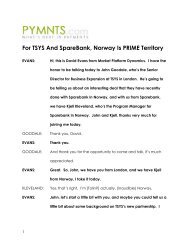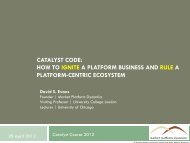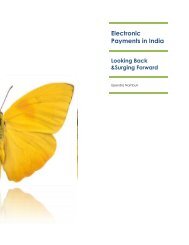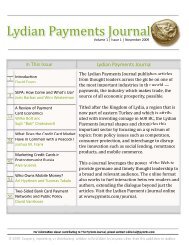Interchange Fees: The Economics and Regulations of What
Interchange Fees: The Economics and Regulations of What
Interchange Fees: The Economics and Regulations of What
- No tags were found...
You also want an ePaper? Increase the reach of your titles
YUMPU automatically turns print PDFs into web optimized ePapers that Google loves.
8 INTERCHANGE FEESpricing in which one group is served at a price close to or even below marginal cost, <strong>and</strong> most orall gross margin is earned by serving the other group. 18It is important to note that many, if not most two-sided markets exhibit this sort <strong>of</strong> asymmetryin pricing <strong>and</strong> gross margin generation. 19 Shopping malls, for instance, <strong>of</strong>ten provide free parkingto consumers, sometimes in expensive parking structures, <strong>and</strong> make all their money by chargingrent to merchants. Yellow Pages <strong>and</strong> competing telephone directories <strong>of</strong> merchants in the UnitedStates are given away to consumers; all the revenue is provided by merchants. 20 Similarly, Micros<strong>of</strong>t<strong>and</strong> Apple do not charge applications s<strong>of</strong>tware developers anything for the highly valuable s<strong>of</strong>twareservices (sometime called APIs) included in their s<strong>of</strong>tware platforms. Both these firms make almostall <strong>of</strong> their money from end-users <strong>of</strong> computer systems. (In Micros<strong>of</strong>t’s case, Windows is usuallylicensed to computer makers that in turn license it to end-users.) On the other h<strong>and</strong>, makers <strong>of</strong>video game consoles sell them to end users at or below cost <strong>and</strong> make most or all <strong>of</strong> their grossmargin from license fees paid by game developers. 21B. Unitary Payment Systems<strong>The</strong> general literature on multi-sided markets has immediate application to the analysis <strong>of</strong> unitarypayment systems—for instance the BankAmericard system before franchising, the AmericanExpress system today (ignoring recent franchise-like bank deals), or the store-specific cards <strong>of</strong>feredby such merchants as Neiman-Marcus. Neglecting for the moment the distinction between access<strong>and</strong> variable prices, the price structure here can be described by the ratio <strong>of</strong> fees paid by merchants,typically in the form <strong>of</strong> the merchant discount, to transaction-related fees paid by consumers,in the form <strong>of</strong> annual <strong>and</strong> other fees. 22 Using this measure, the available evidence indicates thatunitary systems have generally adopted asymmetric pricing structures <strong>and</strong> earned the bulk <strong>of</strong> theirrevenue from merchants, rather than consumers.18We define gross margin here <strong>and</strong> below as revenues minus direct, side-specific variable costs, such as the manufacturingcosts <strong>of</strong> video game consoles. Attributing pr<strong>of</strong>its to one side or another is strictly incorrect, since both sides mustbe on board for pr<strong>of</strong>its to be earned, <strong>and</strong> many costs in platform businesses, like the cost <strong>of</strong> developing the Windowsoperating system, are properly thought <strong>of</strong> as joint between the two sides.19Bolt <strong>and</strong> Tieman (2003) <strong>of</strong>fer an explanation based on the fact that some dem<strong>and</strong> functions that are well-behaved in anordinary one-sided context yield non-concave pr<strong>of</strong>it functions in some two-sided models, thus making corner solutions(for example, prices <strong>of</strong> zero) optimal.20In the payment card context, Vickers (2005) has argued that one might find “a distortion <strong>of</strong> competition” when one side<strong>of</strong> the market is charged “more than all the costs” <strong>of</strong> providing services to both sides. <strong>The</strong>re is no theoretical basis forthis test <strong>of</strong> which we are aware, <strong>and</strong> this sort <strong>of</strong> pricing is not uncommon. It occurs whenever, as in the two examples inthe text, one side <strong>of</strong> a pr<strong>of</strong>itable two-sided business pays nothing, so the other side must be charged “more than all thecosts” if the enterprise is to be pr<strong>of</strong>itable.21See Evans <strong>and</strong> others (2004).22By “transaction-related,” we mean that we are here following almost the entire literature <strong>and</strong> focusing on the paymentfunction <strong>of</strong> credit, charge, <strong>and</strong> debit cards, putting to one side the credit function that only credit cards perform <strong>and</strong> theassociated revenue flow from consumers.








